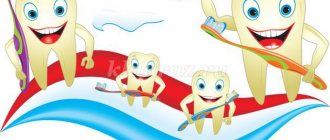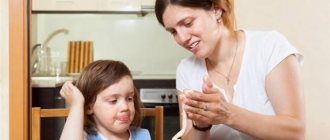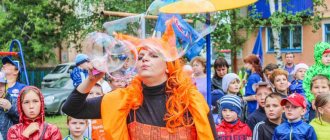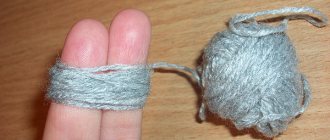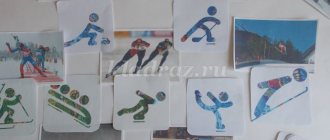The Tale of the Cockerel
Once upon a time there was a Cockerel. He loved to crow loudly and loudly. One winter, he crowed loudly and for a long time early in the morning, and his throat hurt. The cockerel began to cough, sits and grieves. The chicken asked: “Why are you so sad, Petya?”
And he replies: “Yesterday I crowed for a long time in the cold and my neck was frozen and sore. Now I can’t crow.” The chicken says: “We can help your grief: we will tie a warm scarf around your neck, ask the cow for milk, ask the bees for honey, and your throat will stop hurting. And when it’s cold outside, you can’t scream loudly – you can’t crow! Remember this!
How the Hedgehog decided to get sick
The hedgehog walked sadly through the winter forest. He tried to walk slowly in order to arrive at school as late as possible. The hedgehog didn't do his homework, so it would be better if he didn't go to school at all. And the Hedgehog decided to get sick. On the way he ate a lot of snow and went home. And what Hedgehog so wanted happened: he started coughing and his temperature rose, and lying sick at home was so boring and sad.
And at school they waited for Hedgehog all day. After lessons, Losyash, Sovunya and Nyusha decided to visit him. As they thought, Hedgehog did not complete his homework and therefore decided to get sick. Losyash helped Hedgehog do his homework, and Sovunya gave him raspberry jam and gave him hot tea.
A few days later, Hedgehog recovered and decided that it was better to always do his homework on time and go to school with his friends than to lie at home and be sick.
Ryzhik
The little squirrel Ryzhik was nimble. He loved to chew nuts and most of all he loved to jump and jump from branch to branch. His mother taught him this. He jumped carefully, always choosing the strongest branch, not the thinnest one.
One day Ryzhik was playing tag with other little squirrels and fell from a branch. His paw hurt, he couldn’t run or jump at all.
Mom squirrel bandaged his paw with a plantain leaf and gave him medicinal herbs.
Soon Ryzhik recovered and could jump again.
Mishutka has a sweet tooth
Mishutka the bear was very fond of honey, candies, chocolates and other sweets - he ate a lot of them.
Suddenly his stomach hurt.
All his friends came to him, took all the sweets away from him and said: “Mishutka, don’t eat so much sweets, because it gives you a stomach ache. Better eat fruits, vegetables and berries! They are very healthy, they contain a lot of vitamins and you will always be healthy and cheerful, and you won’t get sick!”
How Murka got the flu
Once upon a time there was a cat. Her name was Murka. One day she was hunting for a mouse and caught a mouse that had the flu and ate it. Murka immediately fell ill: her head began to spin, snot started flowing from her nose, and her temperature rose. Murka is lying down, unable to run, crying.
Her puppy friend Sharik took pity on Murka and said: “Let me call Doctor Aibolit to you.” But Murka was afraid of doctors, and she was getting worse and worse. Sharik ran for Aibolit.
Doctor Aibolit examined her, prescribed medicine and cured Murka. And he said to her: “It’s better to eat the meat that the hostess gives, “Whiskas” and drink milk - you will always be healthy!”
A fairy tale in verse on the topic of healthy lifestyle for children in the senior group of kindergarten
Scenario of a fairy tale in verse on the formation of motivation for a healthy lifestyle “To preserve your health, learn to appreciate it!”
Goal: - to form children’s ideas about a healthy lifestyle, as a necessary need of every organism. Objectives: - to involve children in the process of preparing and conducting events aimed at promoting a healthy lifestyle - strengthening the psycho-emotional health of children, creating motivation for a healthy lifestyle. Characters: Microbes ( two people), paints (red, green, blue, pink), four frogs, a butterfly, flowers (four people) At the central wall of the hall there are four modules, which depict drawings depicting a healthy lifestyle. Presenter: In a multi-colored kingdom - a state, colors lived - a friendly family painted the sky, grass, fairy tales, children's smiles, the native land of all! The colors of the sun, puddles, wind, spring rain, melted snow rejoiced. But one day, early in the morning, trouble suddenly happened, When the whole earth was sleeping, Gray boredom entered, bringing friends with it! Microbes enter, to the melody of the song “They say we are beeches - beeches” (music by G. Gladkov, lyrics by Yu. Entin) from the cartoon “The Bremen Town Musicians” they sing: Microbes: 1. We are microbes beeches - beeches, We want to multiply. Everyone surrenders to us without a fight, We will quickly infect everyone. Gray color, pale color Sending you all a big greeting Gray color, pale color That's the secret of health! 2. Every year we come to you and make everyone sneeze. We will ruin your health, In an instant we will drive you to bed, Everyone to bed, everyone to bed, Everyone will get sick and everyone will sneeze, Everyone will be to bed, everyone will be to bed You won’t see bright colors!
Microbes are covered with dark capes over the bright drawings on the easels. Four colors, girls in dresses of different colors - come out and stand in front of the “empty” easels, alternately pronouncing the text anxiously.
Red: Brothers, where did we end up? All the colors suddenly merged into one! This means: gray color, which means there are no colors here. What, will microbes live here? Flu, sore throat and bronchitis Will the children in the group get sick? Will your appetite suddenly disappear? Pink: Everything is dull and sad, You can’t even hear laughter. Maybe it's time for us, girlfriends, to pick up paint again?
Blue: Yes, good idea, We'll paint it grey. And then the children will see - There are no better colors in the world! We will paint the sun with you, so that it can shine, and then in the sun the children will sunbathe together! Green: We will color the river, the meadow! Be healthy all around! Children perform “We will color all the planets”
Green: (walks to her easel) I can paint the grass and the frogs on the pond. Even a Christmas tree and a ditch. I will come to everyone's aid. Four frogs come out. Frog: Green belly and long legs. Frogs - frogs Get used to charging!
The dance “Charging the Little Frogs” is performed to the song “Green grass grows in the swamp.” After the dance, green paint removes the dark cape from the easel Blue: (approaches his easel) The sky is bright blue. Where else can you find something like this? Vitamins of group “B” will bring you benefits. You need to use them to strengthen your nerves, improve metabolism, and reduce excess weight. By the way, you can lose excess weight without miracles at all. Eat less, sleep more, It’s easy to flutter like a butterfly! A girl performs the “Butterfly Dance”
After the dance, the blue paint with the butterfly removes the dark cape from the easel. Red: I'm like the clear sun! Red is beautiful. Both in winter and in summer I paint it red Vegetables and fruits Healthy products! But you should always know that chips are unhealthy food! Once a stroke, another stroke - I’ll draw a meadow!
The “Flower Dance” is performed. After the dance, red, pink paints and flowers open their easels. Presenter: Take your brushes together. We need to color the world, so that it becomes light and bright, like a holiday gift. The most important thing in life is health. Agree, friends. And always treat him with great love! Red: We told you in order How to maintain your health. Start your day with exercise, don't forget about your smile! Now that the exercise is over, we douse ourselves with water and run to the garden for healthy food! Green: Love all nature. In any bad weather, take a walk, harden yourself, frolic to your heart's content. And the rain, hail and sun will look in your window and lift your spirits. Believe me, kids! Pink: Eat a lemon every day - You will be strong and strong, You will stop getting sick and you will sing with happiness! Red: Look, look, the whole world has become colorful!
all the heroes come out. Blue: Can we now arrange a feast of Colors - and it’s no secret! Cheerful, cheerful, cheerful All together: Being healthy is fashionable! The song “We love the seven rules of healthy lifestyle” is performed
We recommend watching:
Leisure scenario for gender education for kindergarten. Junior-middle group Summary of entertainment in kindergarten. Senior group Entertainment for children of the senior group. Scenario Scenario for summer fun in the middle group “Walk in the Forest”
Similar articles:
Lesson in the senior group on the topic: Sport is health
Healthy lifestyle game in kindergarten. Senior group
From the author
Caring for a child’s health is not only about properly organized nutrition and rest. A modern person should know his body well, its needs and capabilities. Without this, you cannot maintain and increase your health. A neglectful or indifferent attitude towards one’s own body and health leads to early aging and illness. From early childhood, when forming a child’s self-awareness, adults must give him knowledge about his physical “I,” which consists not only of external, but also internal organs of the human body. Understanding the simplest physiological processes occurring in humans often keeps children from bad habits and rash actions.
The latest generation of educational programs provide for this area of work. Children are introduced to the concept of “health”, explained how to take care of it and what it means to be healthy; give an idea of the structure of the human body (spine, respiratory, digestive, blood circulation); introduce the concepts of “viruses” and “germs”, talk about how to prevent diseases and what to do if you get sick; give knowledge about the benefits of vitamins and hardening.
In preschool educational institutions, they conduct special classes, conversations, read educational literature, organize didactic games, leisure activities, etc. In a language accessible to children, educators strive to instill an interest in their own body and health, create a desire to be healthy and do everything possible for this.
Educational stories about the prevention of childhood diseases and injuries help children see the problem through the eyes of the heroes of the work, as small as they are. Life situations allow you to try them on yourself, to identify with Masha or Alyoshka, who are mentioned in the story.
Fairy tales are of great importance in the lives of children. She teaches what is good and eternal, helps to believe in oneself and understand oneself, to find the unusual in the ordinary, to get to know the world of adults.
Educational fairy tales attract the attention of children no less than magical ones. They form an interest in the environment and themselves, which serves as the basis for all the child’s cognitive activity. They talk about seemingly simple things. You can listen to a fairy tale many times, memorizing and clarifying its content. It can be played with dolls, dramatized, drawn.
Transforming a fairy tale is one of the most interesting creative activities for a preschooler. There are no restrictions or rules: the child is free in his creativity, and he is accepted by those around him, which is extremely important.
Illustrating fairy tales is another valuable component of the creativity of an older preschooler, associated with the development of imagination, memory, and visual skills.
Reading or telling educational fairy tales goes well with specially organized classes in which children are given educational material and practical activities are organized. A fairy tale can maintain interest in the object being studied or consolidate and clarify existing knowledge. By identifying himself with the heroes of fairy tales, the child in real life begins to pay attention to moments that are significant for his health. For example, do not eat ice cream in large pieces, do not jump from dangerous heights, do not be capricious while taking medications, etc.
In the first section
The book presents the author's didactic games and exercises, riddles, topics of conversation and visual arts.
In the second section
you can find the author's educational tales about the human body. Their uniqueness lies in the fact that the main characters are the organs themselves. The child learns the features of their appearance, location, functions, causes of diseases and their prevention. Fairy tales give an idea of the interconnection and interdependence of all body systems. On the one hand, human internal organs live in a magical land and various incredible events happen to them; on the other hand, fairy tales are based on scientific information. Therefore, children are both passionate and have the opportunity to clarify, expand and consolidate knowledge about themselves. Fairy tales encourage you to be more attentive to the knowledge of your physical “I”, to listen to your own well-being, to distinguish a healthy state from an illness, and to take care of the health of your own and those around you.
All fairy tales are equipped with questions and tasks that will help educators organize communication with children after reading or telling them.
Simple experiments enable children to understand the peculiarities of how their own body works. It is also possible to use simple layouts that give an idea of the physiological process.
Fairy tales have a certain sequence
necessary for a better understanding of the material by children, which is best not to violate.
When starting to read the next fairy tale, do not forget to recall the contents of the previous one with your children. This will help children see the interconnection of all organs of the human body.
In the third section
The content of the author's fairy tales and stories includes childhood diseases and their prevention. They enable the child to identify and remember the main signs of the disease and measures to prevent them. A preschooler, even an older one, often cannot tell adults about what hurts him. This makes it difficult to use prompt assistance. Stories will help children learn to listen to their body and changes in it, and the ability to talk about their well-being.
To the fourth section
included stories and fairy tales about accident prevention. They focus children's attention on possible traumatic situations that can happen to them in real life. There are many such situations, even when the child is at home. Involving children's personal experience helps them better understand the dangers of their behavior on the street, in water, when communicating with fire, animals and in other situations.
In the fifth section
The books contain thematic poems.
All fairy tales, stories and poems are methodically equipped.
The material will allow educators to use different methods and forms of organizing children's activities in their work, which will make it more attractive and effective.
